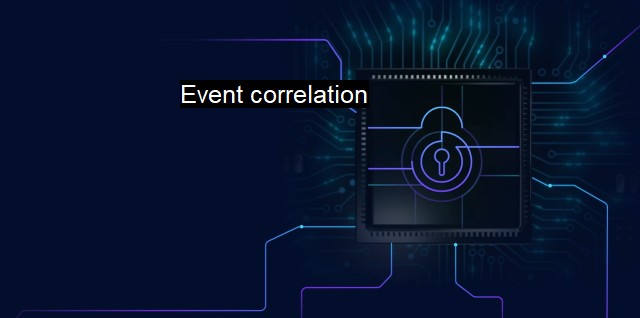What is Event correlation?
The Importance of Event Correlation in Cybersecurity: Analyzing Large Data Volumes to Detect and Mitigate Threats
Event correlation, with refers to a method that not only identifies but also analyzes relationships between different events detected at a particular period of time across diverse cybersecurity solutions deployed in an organization's network. This process can intelligently blend raw data, like virus detections or firewall logs, into meaningful and valuable information, which security analysts rely on to proactively detect any potential security incidents, analyze vulnerability, conform with regulatory needs, and foresee increasingly complex cyberattacks or trends.Cybersecurity environments often generate millions of security logs every day, including antivirus logs, firewall logs, and intrusion detection system logs among others. These logs represent colossal repositories of raw data carrying valuable information about network behavior. with the volume of this data, analyzing each log individually is entirely impractical. This is, comprehensively, the point where event correlation comes into play.
We can think of event correlation in the context of cybersecurity as a form of threat intelligence. It gives security teams a consolidated view of their system's safety, empowering them to respond rapidly and effectively to the threats detected.
A clear value offered by event correlational systems is the ability to interpret massive data. This reduces the volume of data thrown at IT security professionals, enhancing timeliness and relevance towards data handling. Through assembling several separate network events and signals which may relate to a single attack strategy used by cybercriminals, event correlation manages to create an intuitive link and relationship providing more detailed insights that can help prevent such attacks.
Event correlation is integral for formulating risk prioritization strategies. By identifying correlated event sequences, analysts can spot suspicious actions and understand the path of an attack or the early phases, which are often termed as 'kill chains' in cybersecurity. This allows them to not only document instances of possible cyber threats and vulnerabilities but also helps estimate the potential risks concerned with such threats. This way, they are better equipped to prioritize tackling high-risk vulnerabilities that might largely affect the organization.
Integrating event correlation into an antivirus strategy allows for the grounded knowledge to identify and respond effectively to a cyber threat. Antivirus software, along with heuristic and signature-based detection, armored with event correlation analytics, can fight off unknown, zero-day attacks with an increased success rate. While standalone antivirus solutions may stop viruses based on known virus signatures, event-correlated antivirus amplifies its defending capability by analyzing a much more general picture of attack strategies.
Another factor that underscores the significance of event correlation is the complexity of modern cyberattacks and cyber-threat landscapes. Attackers now employ multiple malicious activities like phishing, spamming, injecting Trojan code, and Denial of Service attacks bound into one attack strategy. Tracking these complex cyberattacks independently is nearly impossible through regular checks. Therefore, event correlation systems become crucial, as they play a vital role in spotting out-of-the-ordinary sequences of events and using the gathered information for behavioral analysis, detecting and subsequently acting on anomalies.
In minority cases, correlations might not always denote actual attacks. False-positive rates may increase as a result of event correlation. Therefore, there's a necessity of maintaining well-calibrated correlation algorithms, which are regularly updated with knowledge and insights about most recent cybersecurity threats and trends.
Event correlation is a substantial tool in our quest for robust cybersecurity. It leverages the volume of data from several network points, pieces together a comprehensive view of the information flow, and identifies abnormal behavior in their early stages. This automating and correlating of events frees up significant bandwidth for cybersecurity professionals who can then take informed and timely defensive actions to keep the organization's networks safe.

Event correlation FAQs
What is event correlation in cybersecurity?
Event correlation in cybersecurity refers to the process of linking and analyzing different security events generated by various systems and devices. It helps to identify and prioritize the events that may indicate a potential cyber attack, enabling an organization to respond proactively and effectively.How does event correlation help with antivirus protection?
Event correlation can help with antivirus protection by allowing an organization to identify patterns of activity that could indicate the presence of malware. By correlating information from multiple sources, such as antivirus tools and intrusion detection systems, it becomes easier to detect and respond to viruses and other malicious software.What are some benefits of using event correlation in cybersecurity?
Event correlation can provide several benefits in cybersecurity, including improved threat detection and response times, increased visibility into network activity, and enhanced situational awareness. It can also help reduce the number of false positives generated by security tools, saving time and resources for security teams.What are some challenges associated with event correlation in cybersecurity?
Some challenges associated with event correlation in cybersecurity include the complexity of analyzing data from multiple sources, the need for skilled analysts to interpret results, and the potential for false negatives if events are not correctly correlated. Additionally, organizations may struggle to keep up with the volume of data generated by security tools, making it difficult to identify and prioritize truly significant events.| | A | | | B | | | C | | | D | | | E | | | F | | | G | | | H | | | I | | | J | | | K | | | L | | | M | |
| | N | | | O | | | P | | | Q | | | R | | | S | | | T | | | U | | | V | | | W | | | X | | | Y | | | Z | |
| | 1 | | | 2 | | | 3 | | | 4 | | | 7 | | | 8 | | |||||||